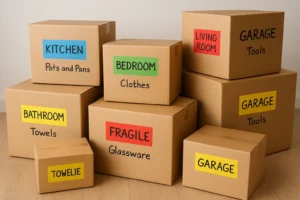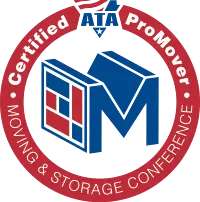Practical Packing Tips for an Organized Move: Expert Advice from Infantry Van Lines

Packing for a move can feel overwhelming, but with the right approach, it becomes a manageable and even efficient process. At Infantry Van Lines, we’ve assisted thousands of clients in streamlining their relocations, and we know that organization is key to reducing stress and preventing damage to your belongings. This guide offers practical tips on packing your items, along with essential supplies you’ll need for a smooth transition. Whether you’re handling the packing yourself or opting for our professional services, these strategies will help you stay on top of things and arrive at your new home ready to unpack with ease.
Start with Preparation: Declutter and Plan Ahead
The foundation of an organized move is preparation. Begin 4-6 weeks before your moving date to avoid last-minute chaos.
- Declutter Ruthlessly: Go through each room and sort items into categories: keep, donate, sell, or discard. This not only lightens your load but also saves on moving costs. Ask yourself if you’ve used the item in the past year—if not, it might be time to let go.
- Create a Packing Timeline: Prioritize packing non-essential items first, like seasonal clothing, books, and decor. Save daily essentials for last. Use a checklist to track progress and assign tasks if you’re moving with family.
- Inventory Your Belongings: Make a detailed list or use an app to catalog your items. This helps with insurance claims and ensures nothing gets left behind.
- Measure and Assess: Check if large furniture will fit through doors and into your new space. Disassemble what you can in advance to make packing easier.
By starting early, you’ll reduce the rush and make the entire process more organized. If you’re short on time, Infantry Van Lines‘s packing experts can handle this step for you.
Essential Packing Items: What You’ll Need
Having the right supplies on hand is crucial for protecting your items and maintaining order. Stock up on these essentials to avoid mid-packing runs to the store.
- Boxes in Various Sizes: Sturdy cardboard boxes are a must—small for heavy items like books, medium for kitchenware, and large for linens. Consider wardrobe boxes for clothes to keep them wrinkle-free.
- Packing Tape and Dispenser: Use heavy-duty tape to secure boxes properly. A dispenser speeds up the process and prevents frustration.
- Protective Materials: Bubble wrap, packing paper, and foam peanuts safeguard fragile items. Old towels or blankets can cushion larger pieces like mirrors or artwork.
- Labels and Markers: Color-coded labels or permanent markers help identify box contents and destination rooms at a glance.
- Specialty Items: Plastic bins for liquids to prevent leaks, mattress bags for hygiene, and stretch wrap for securing drawers or bundling items.
- Tools for Disassembly: Screwdrivers, zip ties, and furniture sliders make breaking down and moving heavy items safer.
At Infantry Van Lines, we offer high-quality packing kits and can deliver them right to your door, ensuring you have everything needed for a professional-level pack.
Room-by-Room Packing Strategies
Tailor your packing to each room’s unique items for maximum efficiency and protection.
- Kitchen: Wrap breakables individually in packing paper and stack plates vertically like records to prevent breakage. Use dividers for glassware and pack pots nested with padding. Label boxes as “Fragile” and avoid overpacking to keep weights manageable.
- Living Room and Bedrooms: Roll clothes instead of folding to save space and reduce wrinkles. Pack books flat in small boxes to distribute weight. For electronics, use original packaging if available, or wrap cords separately and label them.
- Bathroom and Garage: Seal liquids in plastic bags to contain spills. Pack tools in their cases or use dividers in boxes. Dispose of hazardous materials like paints or chemicals responsibly, as they may not be transportable.
- Fragile and Valuable Items: Use extra padding for artwork, mirrors, and antiques. Consider custom crating for high-value pieces—Infantry Van Lines specializes in this for added peace of mind.
- Essentials Box: Prepare a “first-night” box with toiletries, medications, a change of clothes, snacks, and important documents for easy access upon arrival.
Remember to pack heavier items at the bottom of boxes and lighter ones on top. Fill gaps with padding to prevent shifting during transit.
Organization Tips: Labeling and Tracking
Staying organized during packing sets the stage for an easy unpack.
- Color-Coding System: Assign colors to rooms (e.g., blue for kitchen, green for bedroom) and label boxes accordingly. This helps movers place them directly in the right spots.
- Detailed Labels: Note contents on multiple sides of the box, including specifics like “Kitchen – Pots and Pans” or “Fragile – Glassware.”
- Number Your Boxes: Assign numbers and cross-reference with your inventory list for quick checks.
- Digital Tools: Use apps to scan labels or track boxes via QR codes for tech-savvy organization.
- Pack Last, Unpack First: Clearly mark boxes with essentials so they’re loaded last and unloaded first.
These methods not only speed up the moving day but also make settling in faster and less stressful.

Final Thoughts: Making Your Move Stress-Free
With these practical tips and essential items, your packing process can transform from a chore into a well-orchestrated plan. At Infantry Van Lines, we’re here to support you every step of the way—whether through our full packing services, supply deliveries, or expert advice. An organized move saves time, money, and sanity, allowing you to focus on the excitement of your new chapter.
Ready to get started? Contact Infantry Van Lines today for a free consultation and personalized moving plan. Let’s make your relocation seamless!






